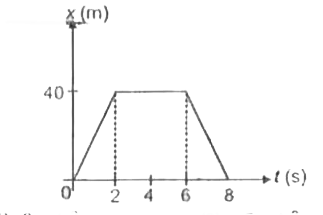A particle moves along the x - axis according to x=A[1+sinωt]. What distance does is travel in time interval from t=0 to t=2.5π/ω ?
4A
6A
5A
3A
The correct Answer is:C
To solve the problem, we need to determine the distance traveled by the particle in the time interval from t=0 to t=2.5πω given the equation of motion x=A(1+sin(ωt)).
1. Identify the Time Period:
The motion described is periodic, and the time period T of the sine function is given by:
T=2πω
2. Break Down the Time Interval:
The time interval from t=0 to t=2.5πω can be expressed as:
t=2.5πω=2πω+0.5πω=T+T4
This indicates that the particle completes one full cycle (from t=0 to t=T) and then moves an additional T4 (which is 14 of the period).
3. Determine the Positions:
- At t=0:
x(0)=A(1+sin(0))=A(1+0)=A
- At t=T (one complete cycle):
x(T)=A(1+sin(2π))=A(1+0)=A
- At t=T4 (quarter period):
x(T4)=A(1+sin(π2))=A(1+1)=2A
4. Calculate the Distance Traveled:
- From t=0 to t=T, the particle travels from A to A (back to the starting point), covering a distance of 0.
- From t=T to t=T4, the particle moves from A to 2A (the maximum position), covering a distance of:
2A−A=A
- Then, it returns back from 2A to A, covering another distance of A.
5. Total Distance:
The total distance traveled in the time interval t=0 to t=2.5πω is:
Total Distance=A+A=2A
Final Answer:
The distance traveled by the particle in the time interval from t=0 to t=2.5πω is 2A.
The motion described is periodic, and the time period T of the sine function is given by:
T=2πω
The time interval from t=0 to t=2.5πω can be expressed as:
t=2.5πω=2πω+0.5πω=T+T4
This indicates that the particle completes one full cycle (from t=0 to t=T) and then moves an additional T4 (which is 14 of the period).
- At t=0:
x(0)=A(1+sin(0))=A(1+0)=A
- At t=T (one complete cycle):
x(T)=A(1+sin(2π))=A(1+0)=A
- At t=T4 (quarter period):
x(T4)=A(1+sin(π2))=A(1+1)=2A
- From t=0 to t=T, the particle travels from A to A (back to the starting point), covering a distance of 0.
- From t=T to t=T4, the particle moves from A to 2A (the maximum position), covering a distance of:
2A−A=A
- Then, it returns back from 2A to A, covering another distance of A.
The total distance traveled in the time interval t=0 to t=2.5πω is:
Total Distance=A+A=2A
The distance traveled by the particle in the time interval from t=0 to t=2.5πω is 2A.
Topper's Solved these Questions
- BOOK - DC PANDEY ENGLISHCHAPTER - SIMPLE HARMONIC MOTIONEXERCISE - Level 2 More Than One Correct8videos
SIMPLE HARMONIC MOTION
- BOOK - DC PANDEY ENGLISHCHAPTER - SIMPLE HARMONIC MOTIONEXERCISE - Level 2 Comprehension2videos
SIMPLE HARMONIC MOTION
- BOOK - DC PANDEY ENGLISHCHAPTER - SIMPLE HARMONIC MOTIONEXERCISE - Level 1 Subjective39videos
SIMPLE HARMONIC MOTION
- BOOK - DC PANDEY ENGLISHCHAPTER - SEMICONDUCTORS AND ELECTRONIC DEVICESEXERCISE - More than One Option is Correct3videos
SEMICONDUCTORS AND ELECTRONIC DEVICES
- BOOK - DC PANDEY ENGLISHCHAPTER - SOLVD PAPERS 2017 NEET, AIIMS & JIPMEREXERCISE - Solved paper 2018(JIPMER)38videos
SOLVD PAPERS 2017 NEET, AIIMS & JIPMER
Similar Questions
A particle moves along the x-axis according to the equation x=asinωt+bcosωt. The motion is simple harmonic with
View SolutionA particle is moving along the y-axis according to the equation[y=a0sin(3ωt)]. The motion is simple harmonic
View SolutionA particule moves in x - y plane acording to rule x = a sin ωt and y = a cos ωt. The particle follows
View SolutionA particle moves according to the law, x=acos(πt/2). . What is the distance covered by it in time interval t=0 to t=3 second.
View SolutionA particle moves according to the equation x=acosπt. The distance covered by it in 2.5 s is
View SolutionWhat is the time - period of x=Asin(ωt+α)?
View SolutionA particle moves according to the law x=rcos(pi)t/(2) The distance covered by it in the time interval between t=0 to t=3s is
View SolutionThe position of a particle along X-axis at time t is given by x=2+t−3t2. The displacement and the distance travelled in the interval, t = 0 to t = 1 are respectively
View SolutionThe position (x) of a particle moving along x - axis veries with time (t) as shown in figure. The average acceleration of particle in time interval t = 0 to t = 8 s is
 View Solution
View SolutionA particle move a distance x in time t according to equation x=(t+5)−1. The acceleration of particle is proportional to.
View Solution

